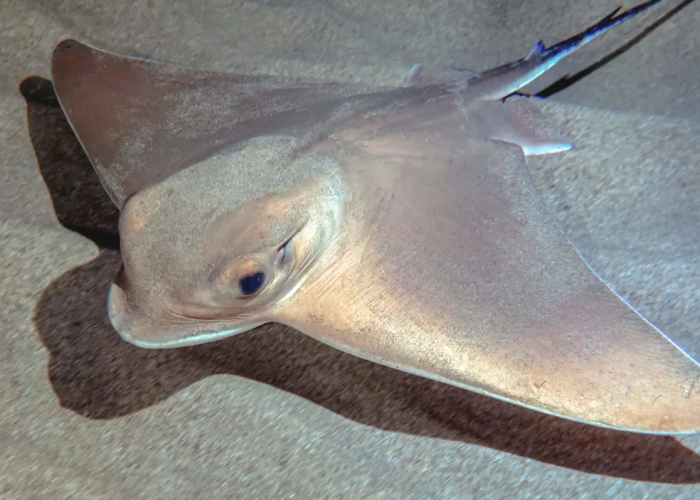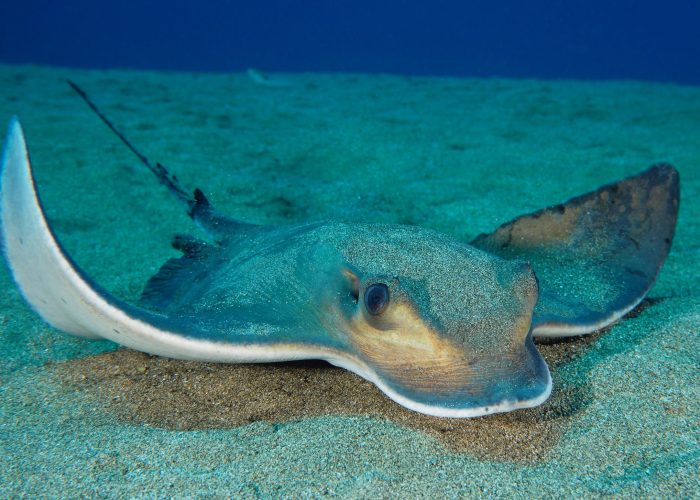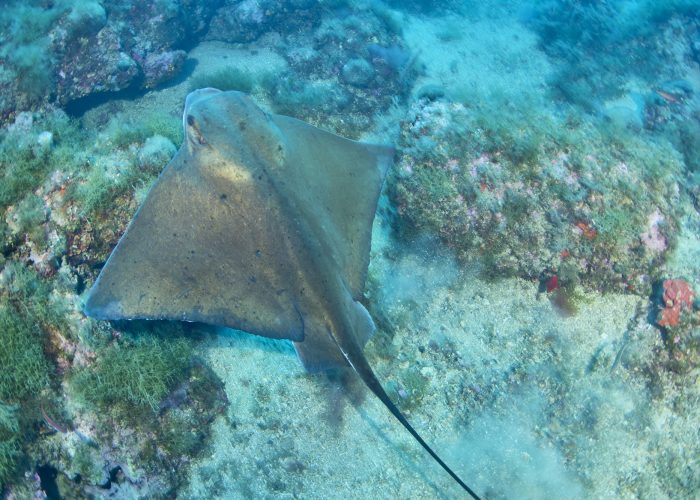Myliobatis aquila
- Common name : Common Eagle Ray
- Order: Myliobatiformes
- Family: Myliobatidae
- Synonyms: Raja aquila, Leiobatus aquila, Raia rhombus, Myliobatis noctula, Myliobatis cervus, Holorhinus aquila.
- Misidentifications: Aetomylaeus bovinus
Short description
Medium-sized to large eagle ray. Head thick distinct from disk forming a rostrum like a broad projection. Short, rounded and prominent snout. Upper or lower jaw with seven rows of flat teeth. Two large eyes positioned laterally. Pectoral rhombic disc with very angular corners. Single dorsal fin, associated with one or two dorsal darts, behind pelvic fin tips. No caudal and anal fin. Thin and long tail, like a whip, that reaches 2 to 2.5 times the wingspan.
Color: Golden bronze or dark brown dorsal surface and white ventral surface with one brownish margin.
Measurements:
- Disk width (DW): 80-150 cm (max 183 cm)
- Total length (TL): 60-70 cm (max 260 cm)
- Weight: up to 30 kg
Swimming pattern: Oscillatory locomotion.
Biology / Ecology
Feeds on benthic crustaceans, mollusks and fishes.
Behavior: Often found in groups.
Reproduction: Viviparous (aplacental viviparity with histotrophy). Size at maturity (DW): 32-40 cm male and 43-60 cm female. Gestation period: 6-8 months. Juveniles per litter: 3-7. Size at birth (DW): ~19 cm.
Habitat: Benthic and semi-pelagic in subtropical and temperate water. Inhabits sandy-muddy zones in coastal environments from surface to 200 m (max 537 m) of depth. Also found in shallow lagoons, bays, estuaries and offshore.
Identified as the species most impacted by pelagic trawlers in the Adriatic Sea.
Distinguishing characteristics
- Wing-shaped pectoral fin with pointed extremity.
- Dorsal fin behind pelvic fin tips.
- Front lobe of pectoral fin under a short, rounded and prominent snout.
Myliobatiformes: No caudal and anal fin. Thin tail like a whip.
Myliobatidae: Short fleshy rostral lobe, connecting to pectoral fin by a ridge at eye level. Large caudal sting behind the dorsal fin.
Distribution
Worldwide: From the British Isles and the southern North Sea to South Africa and Western Indian Ocean. Absent from Black Sea.
Mediterranean:
- Occurrence: Occasional in the central Mediterranean Sea and in the Adriatic Sea. Rare in the western and eastern Mediterranean Sea.
- Latest records: Malta (2023), Adriatic Sea (2015), Corsica (2012), Spain (2012), Turkey (2011), Balearic Sea (2009), France (2009). Greece – Aegean Sea (2010), Algeria (2003).

Any recent observation not on the map?
Contact us!
Conservation
Threats: Commercial species in several areas of the Mediterranean Sea. Not intensively fished but regularly caught as an accidental by-catch (mainly in nets). A traditional food item in the Adriatic and in the Maghreb. Highly esteemed flesh.
Protection level:
- Global: Critically Endangered (IUCN 2021, last assessment: 2020)
- Mediterranean: Vulnerable (IUCN 2016, last assessment: 2016)
- Europe: Vulnerable (IUCN 2015, last assessment: 2014)
Key references
- Agius A., Borg J. A., Schembri P. J. 2024. Batoid fishes associating with tuna farms in Malta. Rapp. Comm. int. Mer Médit. 43: 273.
- Damalas D., Vassilopoulou V. 2011. Chondrichthyan by-catch and discards in the demersal trawl fishery of the central Aegean Sea (Eastern Mediterranean). Fisheries Research 108(1): 142-152.
- Carpentieri P., Nastasi A., Sessa M., Srour A. 2021. Incidental catch of vulnerable species in Mediterranean and Black Sea fisheries – A review. General Fisheries Commission for the Mediterranean – Studies and Reviews 101: I-317.
- Follesa M. C., Marongiu M. F., Zupa W., Bellodi A., Cau A., Cannas R., Colloca F., Djurovic M., Isajlovic I., Jadaud A., Manfredi C., Mulas A., Peristeraki P., Porcu C., Ramirez-Amaro S., Salmerón Jiménez F., Serena F., Sion L., Thasitis I., Cau A., Carbonara P. 2019. Spatial variability of Chondrichthyes in the northern Mediterranean. Scientia Marina 83(S1): 81-100.
- Fortuna C.M., Vallini C., Filidei Jr E., Ruffino M., Consalvo I., Di Muccio S., Gion C., Scaccoa U., Tarullia E., Giovanardi O., Mazzola A. 2010. By-catch of cetaceans and other species of conservation concern during pair trawl fishing operations in the Adriatic Sea (Italy). Chemistry and Ecology 26: 65-76.
- Giovos I., Serena F., Katsada D., Anastasiadis A., Barash A., Charilaou C., Hall-Spencer J.M.,Crocetta F.,Kaminas A., Kletou D, Maximiadi M., Minasidis V., Moutopoulos D.K., Aga-Spyridopoulou R.N., Thasitis I., Kleitou P. 2021. Integrating literature, biodiversity databases, and citizen-science to reconstruct the checklist of Chondrichthyans in Cyprus (Eastern Mediterranean Sea). Fishes 6(3): 24.
- Zogaris S., Dussling U. 2010. On the occurrence of the bull ray Pteromylaeus bovinus (Chondrichthyes: Myliobatidae) in the Amvrakikos Gulf, Greece. Mediterranean Marine Science 11(1): 177-184.



